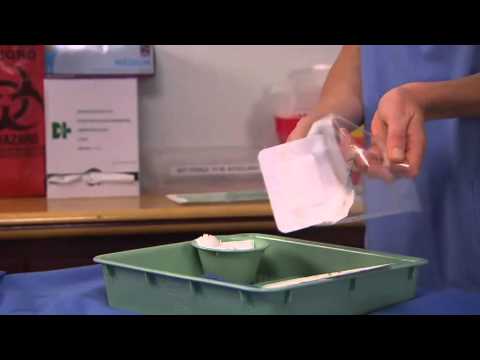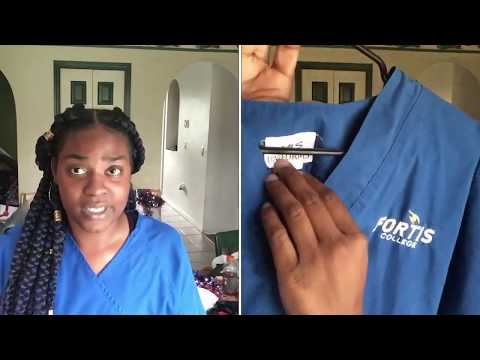Wound Care for Medical Assistants
Contents [show]
Wound care is an important part of the medical assistant’s scope of practice. This blog will explore the different types of wounds, how to care for them, and when to refer to a physician.
Checkout this video:
Wound Care Basics
As a medical assistant you may be called upon to provide wound care for patients. Wound care is an important part of the healing process, and there are certain basics that you should be familiar with.
There are three main types of wounds: incisions, lacerations, and abrasions. Incisions are clean cuts made by a sharp object, such as a knife or razor. Lacerations are ragged tears in the skin, often caused by blunt trauma. Abrasions are scrapes or scratches on the surface of the skin.
Wounds can also be classified according to their depth. Superficial wounds only involve the top layer of skin, while partial-thickness wounds extend into the lower layers of skin. Full-thickness wounds go all the way through the skin and may involve underlying tissues, such as muscle or bone.
Wound healing occurs in three stages: inflammation, proliferation, and maturation. Inflammation is the body’s initial response to injury and is characterized by redness, swelling, and pain. This stage lasts for 1-3 days. Proliferation is characterized by the formation of new tissue at the wound site. This stage lasts for 3-21 days. Maturation is characterized by the remodeling of new tissue and lasts for 21 days to 2 years.
There are several factors that can affect wound healing, such as age, nutrition, medications, smoking, diabetes, and comorbidities such as hypertension or cardiovascular disease. Treatment for a wound will vary depending on its type and depth, as well as any underlying factors that may be affecting healing.
basics of wound care so that you can provide safe and effective care for your patients.
Assessing the Wound
When you are assessing a wound, you will need to take into account the size, depth, location, and any other factors that may be present. The depth of the wound is judged by how deep the deepest part of the wound goes. The smaller the number, the more shallow the wound. A stage 1 pressure ulcer, for instance, has not penetrated past the epidermis. A stage 4 pressure ulcer has gone through all layers of skin and into muscle or bone.
The size of the wound is often judged by measuring the length and width of the area involved. This can be done with a ruler or tape measure. The area can also be estimated by using your hand to measure. Another way to determine size is by using descriptive terms such as small (1-2 cm), medium (3-6 cm), or large (greater than 6 cm).
Location is important when assessing a wound because certain areas are more prone to problems than others. For example, a foot ulcer is more likely to become infected than an ulcer on the arm. This is because there is less blood flow to the feet and they are often in contact with dirty surfaces.
Cleaning the Wound
One of the most important aspects of wound care is cleaning the wound. This step helps remove debris, dirt, and bacteria that could potentially cause infection. The type of wound will dictate the best method of cleaning. For example, wounds with a lot of drainage may require more than one cleansing to prevent further contamination.
Here are some general guidelines for cleaning wounds:
– Wear gloves when cleaning the wound.
– Use a mild soap and warm water to clean the wound. Do not use hydrogen peroxide or alcohol, as these can damage tissue.
– Gently cleanse the wound with a soft washcloth or cotton swab. Avoid scrubbing, as this can irritate the wound and delay healing.
– Rinse the wound with warm water and pat dry with a clean towel.
Applying a Bandage
One of the most common duties of a medical assistant is to apply a bandage to a patient’s wound. Here is a step-by-step guide on how to properly apply a bandage:
1. Wash your hands with soap and water, or use an alcohol-based hand sanitizer, before handling the patient’s wound.
2. Inspect the wound for any signs of infection, such as redness, swelling, or pus. If you see any of these signs, inform the patient’s nurse or doctor.
3. If the wound is bleeding, apply pressure with a clean cloth to help stop the bleeding.
4. Once the bleeding has stopped, clean the wound with soap and water or an antiseptic solution. Be sure to remove any dirt or debris from the wound.
5. Apply a thin layer of an antibiotic ointment to the wound if recommended by the patient’s nurse or doctor.
6. Place a clean gauze pad over the wound and secure it in place with adhesive tape or staples, if needed.
7. Wrap an elastic bandage around the gauze pad and secure it in place with adhesive tape. Be sure not to wrap the bandage too tightly, as this could impair circulation.
Specialty Wound Care
As a medical assistant you may be called upon to provide wound care for patients with a variety of wounds. While the basic principles of wound care remain the same, there are some special considerations to take into account when caring for certain types of wounds.
Pressure ulcers, also known as bed sores, occur when there is too much pressure on one area of the body. This can happen when a person is confined to a bed or wheelchair, or if they are pregnant. Pressure ulcers can be very painful, and if they become infected, they can be life-threatening.
Burns can range from mild to severe, and require different types of treatment depending on their severity. First-degree burns only affect the outer layer of skin, while second- and third-degree burns damage deeper layers of skin and tissue. Burns can also be caused by chemicals, electricity, or extreme cold.
Amputations are usually the result of an accident or surgery. If you are caring for a patient who has had an amputation, it is important to keep their stump clean and dry to prevent infection. You will also need to help them keep their balance and avoid falls.
These are just a few examples of specialty wound care that Medical assistants may be called upon to provide. No matter what type of wound you are caring for, always follow the instructions of the patient’s doctor or nurse.
When to Seek Further Treatment
If the wound is large or deep, it may require professional medical treatment. A large or deep wound may need stitches or other types of closure, such as staples or skin adhesives, to hold the cut together until it heals. In some cases, a surgeon may need to clean out the wound and insert drainage tubes to prevent infection and help the wound heal from the inside out.
Caring for Different Types of Wounds
Working as a medical assistant you will most likely encounter different types of wounds in your patients. It is important to know how to properly care for each type in order to prevent infection and promote healing.
There are four main types of wounds:
-Abrasions: Abrasions occur when the top layer of skin is scraped off, usually from a fall or other accident. To care for an abrasion, clean the wound with soap and water, then apply a bandage.
-Lacerations: Lacerations are deeper cuts that go through all layers of skin. They may be caused by a sharp object, such as a piece of glass or a knife. To care for a laceration, clean the wound with soap and water, then apply pressure to stop any bleeding. Once the bleeding has stopped, close the wound with stitches or surgical tape and apply a bandage.
-Punctures: Punctures are small holes in the skin caused by something sharp, like a nail or a needle. To care for a puncture wound, clean the wound with soap and water and apply an antibiotic ointment. Cover the wound with a bandage.
-Burns: Burns can be either first-, second-, or third-degree burns, depending on how deep they go into the skin. First-degree burns only affect the top layer of skin and usually heal on their own. To care for a first-degree burn, run cool water over the area for several minutes and then apply aloe vera gel or antibiotic ointment. Second-degree burns affect both the top layer of skin and the layer below it (the dermis). These burns are more painful and often require medical attention. To care for a second-degree burn at home, run cool water over the area for several minutes and then cover it with sterile gauze or wrap it in plastic wrap to keep air off of it. Third-degree burns penetrate all layers of skin and often damage nerves and muscles as well. These burns require immediate medical attention; do not try to treat them at home!
Wound Care in Pediatrics
As a medical assistant you will likely encounter many different types of wounds in your career. Wound care is an important part of medical care, and it is important to be familiar with the different types of wounds and the best way to care for them.
Wounds in pediatrics can be particularly challenging because children’s skin is thinner and more delicate than adults’, making them more susceptible to infection. It is important to be gentle but thorough when cleaning and dressing pediatric wounds.
There are four main types of wounds: incisions, lacerations, abrasions, and punctures. Incisions are clean, straight cuts made by a sharp object, such as a knife or scalpel. Lacerations are ragged, uneven cuts that may be jagged or irregular in shape. Abrasions are scrapes or scratches on the surface of the skin. Punctures are deep, narrow wounds made by a sharp object, such as a nail or needle.
Infection is always a risk with any type of wound, but it is especially important to watch for signs of infection in pediatrics patients. Signs of infection include redness, swelling, drainage from the wound, increased pain, or fever. If you notice any of these signs, it is important to notify the child’s physician or nurse immediately.
Wound care includes cleansing the wound, applying a dressing (if necessary), and monitoring the wound for signs of infection. It is important to use gentle but thorough techniques when caring for pediatric wounds. The following steps will help you properly care for pediatric incisions:
1) Wash your hands thoroughly with soap and water before touching the wound.
2) Select appropriate supplies: gauze pads, adhesive tape (hypoallergenic if possible), clean gloves (if necessary).
3) Gently cleanse the wound with mild soap and warm water using gentle circular motions (do not scrub). Rinse well and pat dry with a clean gauze pad or cloth. Be sure to remove any dirt or debris from inside the wound before proceeding to step 4.
4) Apply an antibiotic ointment to the gauze pad or cotton swab and gently apply it to the surface of the wound (do not put ointment inside the wound). You may also use a non-adhesive bandage if desired. Be sure not to put too much pressure on the wound while applying the bandage so as not to cause pain.
Wound Care in the Elderly
Elderly patients are especially susceptible to wounds and wound infections. Poor nutrition, age-related changes in the skin, and underlying medical conditions can all contribute to impaired wound healing. As a medical assistant, you will play an important role in the care of elderly patients with wounds.
The most common types of wounds seen in the elderly are pressure ulcers, venous stasis ulcers, and diabetic ulcers. Pressure ulcers are caused by unrelieved pressure on the skin, which can occur when a patient is immobile or has poor circulation. Venous stasis ulcers are caused by poor circulation in the legs, which can lead to pooling of blood and tissue damage. Diabetic ulcers are caused by nerve damage and poor circulation, which can occur in patients with diabetes.
When caring for elderly patients with wounds, it is important to keep the following things in mind:
-Wounds heal best when they are kept clean and moist. Be sure to cleanse the wound regularly with soap and water or an appropriate wound cleanser.
-To help keep the wound moist, use a dressing that will create a moist environment for healing. Hydrogel dressings, for example, are often used for this purpose.
-Remove dressings and assess the wound daily. Look for signs of infection, such as redness, tenderness, swelling, or drainage. Also check for new or worsening wounds. If you see any of these signs, notify the patient’s doctor or nurse immediately.
-Elderly patients with wounds may be at risk for developing malnutrition. Be sure to assess their nutritional status and refer them to a registered dietitian if necessary.
-Be sure to educate your patients on how to care for their wounds at home. Teach them about proper cleansing, dressing changes, and signs of infection
Wound Care in Special Populations
The elderly, disabled, and bedridden are at high risk for pressure ulcers. Diabetics are also at high risk for foot ulcers. Understanding how to properly care for wounds in special populations is an important part of wound care for Medical Assistants
The elderly are more prone to developing pressure ulcers due to a decrease in activity and mobility. The disabled and bedridden are also at risk for developing pressure ulcers due to the same reasons. Diabetics are more prone to developing foot ulcers due to the possibility of poor circulation and nerve damage in the feet.
When caring for wounds in special populations, it is important to be gentle and patient. Be sure to clean the wound thoroughly and apply dressing as directed. If you have any questions or concerns, be sure to speak with a supervisor or doctor.







